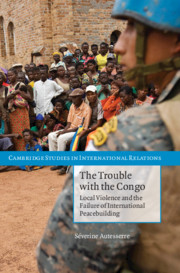Book contents
- Frontmatter
- Contents
- List of Figures and Tables
- Glossary of Acronyms, Names, and Ethnic Terms
- 1 Map of the Democratic Republic of the Congo and Its Neighbors
- Preface and Acknowledgments
- 1 The Peacebuilding World
- 2 A Top-Down Problem
- 3 A Top-Down Solution
- 4 A Bottom-Up Story
- 5 The Defeat of Bottom-Up Solutions
- 6 Beyond the Congo
- Appendix: Chronology
- Bibliography
- Index
- Cambridge Studies in International Relations
6 - Beyond the Congo
Published online by Cambridge University Press: 05 June 2012
- Frontmatter
- Contents
- List of Figures and Tables
- Glossary of Acronyms, Names, and Ethnic Terms
- 1 Map of the Democratic Republic of the Congo and Its Neighbors
- Preface and Acknowledgments
- 1 The Peacebuilding World
- 2 A Top-Down Problem
- 3 A Top-Down Solution
- 4 A Bottom-Up Story
- 5 The Defeat of Bottom-Up Solutions
- 6 Beyond the Congo
- Appendix: Chronology
- Bibliography
- Index
- Cambridge Studies in International Relations
Summary
The e-mail signature of Kemal Saiki, the spokesperson of the United Nations Mission in the Congo (MONUC) during most of the transition, included a fitting – and quite clichéd – quotation attributed to the British leader and political theorist Edmund Burke: “All that's necessary for the forces of evil to win in the world is for enough good men to do nothing.” Saiki probably did not recognize the irony. During the Congolese transition, the “good men” staffing his organization, the diplomatic missions, and most nongovernmental agencies did nothing to assuage local tensions. As a result, the “forces of evil” – or, in modern language, the perpetrators of massive human right violations – won the eastern Congo.
This book started with a puzzle: Even though the Congo is the stage of intense international peacebuilding efforts, and even though it recently experienced a transition from war to “peace and democracy,” it continues to be plagued by the deadliest conflict since World War II. Why did the international intervention fail to help the Congo achieve lasting peace and security? I proposed a straightforward answer. Bottom-up rivalries over land, resources, and political power explain, in large part, why organized violence persisted in the eastern provinces after the Congo was supposedly at peace, and why war resumed in late 2008. However, a dominant peacebuilding culture shaped the intervention strategy in a way that precluded action on local conflicts. Most international actors interpreted “postconflict” fighting as the consequence of regional and national tensions alone.
- Type
- Chapter
- Information
- The Trouble with the CongoLocal Violence and the Failure of International Peacebuilding, pp. 231 - 272Publisher: Cambridge University PressPrint publication year: 2010

